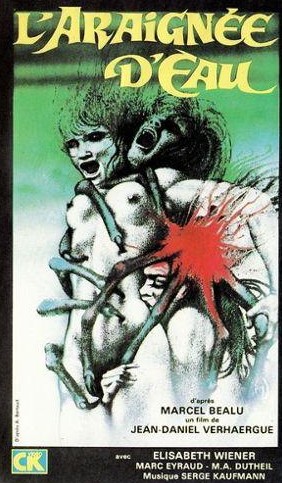 This oddity, hailing from early 1970s France, is the only movie about a tiny water spider transforming into a full-sized woman that I know of. The 1947 story “The Water Spider,” a surreal account of love and transformation, is one of the key works of the late French fantasy-horror maestro Marcel Bealu (and can be found in English in the 2012 anthology UNSTUCK #2). This 1971 film adaptation (which is a.k.a. L’ARAIGNEE D’EAU), the feature debut of Belgian filmmaker Jean-Daniel Verhaeghe, was something of a rarity amid French cinema of the early 1970s, in which horror and fantasy-themed fare was pretty scant. That probably explains why the film fell into immediate and long-lasting obscurity.
This oddity, hailing from early 1970s France, is the only movie about a tiny water spider transforming into a full-sized woman that I know of. The 1947 story “The Water Spider,” a surreal account of love and transformation, is one of the key works of the late French fantasy-horror maestro Marcel Bealu (and can be found in English in the 2012 anthology UNSTUCK #2). This 1971 film adaptation (which is a.k.a. L’ARAIGNEE D’EAU), the feature debut of Belgian filmmaker Jean-Daniel Verhaeghe, was something of a rarity amid French cinema of the early 1970s, in which horror and fantasy-themed fare was pretty scant. That probably explains why the film fell into immediate and long-lasting obscurity.
Bernard is a writer living in a rural village who’s become distant with his wife Catherine, who accuses him of not loving her anymore. Frustrated, Bernard embarks on a new writing project that may be a recollection or a fantasy.
Bernard’s account, whose events take up the remainder of the film, begins with Bernard finding a tiny water spider in a lake near his house. He puts the spider in a tin box and takes it home, where he grows strangely obsessed with it. Confined to Bernard and Catherine’s attic, the spider begins growing larger, and eventually forms itself into a beautiful woman Bernard christens Nicky.
Bernard of course neglects Catherine, who grows disenchanted. Nicky, meanwhile, takes to dressing up in stolen clothes, and the smitten Bernard doesn’t discourage her. Malicious gossip begins to spread among the villagers, and Catherine grows suspicious. She eventually departs, leaving Bernard alone with Nicky.
One day some villagers throw stones at Bernard’s house, breaking several windows. He retaliates by letting a sack full of feisty cats loose in the local church, disrupting a prayer service.
Shortly thereafter Catherine returns home, where she tries to bash Nicky’s head in with a heavy candle. The attempt fails, forcing the women into an uneasy alliance—until Nicky catches Bernard and Catherine having sex, which freaks her out completely…
There’s a compelling, and appropriately dreamlike, simplicity to this film. It has a striking visual elegance, with circular camera movements that sinuously wind around characters and objects, and gorgeous candlelit imagery (a large portion of the film takes place at night). It suffers nonetheless from an uneventful narrative and too many repetitive shots of the protagonist ascending a darkened stairway, not to mention an extremely noisy and distracting music score.
The transformation of the titular spider into actress Elisabeth Wiener is accomplished via determinedly old-fashioned means, i.e. a lot of close-ups and dissolves. The effect is primitive, but not entirely unsatisfying. Special effects, however, are not what make THE WATER SPIDER the mildly effective reverie it is; rather, it’s the unshowy surrealism and burnished visuals that give the film its fantastic and subtly poetic allure.
Vital Statistics
THE WATER SPIDER (L’ARAIGNEE D’EAU)
Productions Tanit
Director: Jean-Daniel Verhaeghe
Screenplay: Jean-Daniel Verhaeghe
(Based on a story by Marcel Bealu)
Cinematography: Jean Gonnet
Editing: Marie-Claire Korber
Cast: Marc Eyraud, Marie-Ange Dutheil, Elisabeth Wiener, Andre Julien, Pierre Meyrand, Juliet Berto, Josep Maria Flotats
